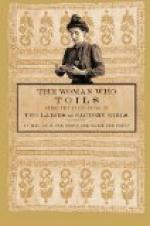I make an appeal to all those whose interests and leisure permit them to help in this double emancipation of the woman who toils for bread and the girl who works for luxuries.
* * * * *
MARIE VAN VORST
INTRODUCTORY
VII. A MAKER OF SHOES AT LYNN
VIII. THE SOUTHERN COTTON MILLS
IX. THE CHILD IN THE SOUTHERN MILLS
* * * * *
CHAPTER VI
INTRODUCTORY
There are no words too noble to extol the courage of mankind in its brave, uncomplaining struggle for existence. Idealism and estheticism have always had much to say in praise of the “beauty of toil.” Carlyle has honoured it as a cult; epics have been written in its glory. When one has turned to and performed, day in and day out, this labour from ten to thirteen hours out of the twenty-four, with Sundays and legal holidays as the sole respite—to find at the month’s end that the only possible economics are pleasures—one is at least better fitted to comprehend the standpoint of the worker; and one realizes that part of the universe is pursuing means to sustain an existence which, by reason of its hardship, they perforce cling to with indifference. I laid aside for a time everything pertaining to the class in which I was born and bred and became an American working-woman. I intended, in as far as was possible, to live as she lived, work as she worked. In thus approaching her I believed that I could share her ambitions, her pleasures, her privations.
Working by her side day after day, I hoped to be a mirror that should reflect the woman who toils, and later, when once again in my proper sphere of life, to be her expositor in an humble way—to be a mouthpiece for her to those who know little of the realities of everlasting labour.
I have in the following pages attempted to solve no problem—I have advanced no sociologic schemes. Conclusions must be drawn by those who read the simple, faithful description of the woman who toils as I saw her, as I worked beside her, grew to understand in a measure her point of view and to sympathize with her struggle.
MARIE VAN VORST.
Riverdale-on-Hudson,
1902.
* * * * *
A MAKER OF SHOES AT LYNN
* * * * *
CHAPTER VII
A MAKER OF SHOES AT LYNN
“Those who work neither with their brains nor their hands are a menace to the public safety.”—Roosevelt.
Well and good! In the great mobs and riots of history, what class is it which forms the brawn and muscle and sinew of the disturbance? The workmen and workwomen in whom discontent has bred the disease of riot, the abnormality, the abortion known as Anarchy, Socialism. The hem of the uprising is composed of idlers and loungers, indeed, but it is the labourer’s head upon which the red cap of protest is seen above the vortex of the crowd.




